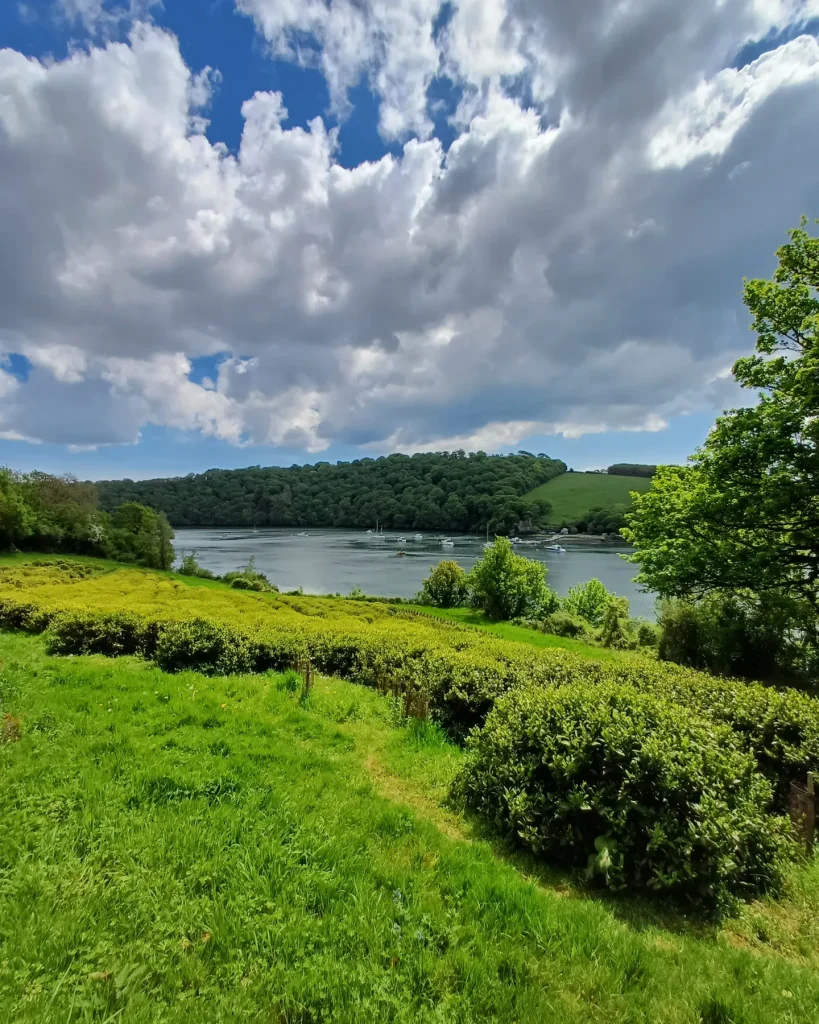Cathy Turner

The Southeast wind turns South up the Fal Estuary, Cornwall, picking up moisture before depositing it on the tea fields along the river’s West coast.
It was the garden camellia that arrived first, brought to the UK on East India Company ships in the late 18th and 19th centuries, for British landowners. At first, Camellias were assumed to be delicate, and to need cultivation under glass. It was not until the mid-19th century that they were found to be able to withstand the British weather. The camellias (C. japonica) grown at the Tregothnan Estate, owned by the Boscawen family, then and now, are some of the earliest plantings in the open (there is even a maze grown from camellia bushes).
More recently, the success of the ornamental camellias gave rise to the idea of growing C. sinensis – tea plants – and a grant from the Nuffield Foundation supported Head Gardener, Jonathan Jones, to conduct research into growing tea commercially in Cornwall. This included research in Darjeeling in 2000, which Jones remarks has a climate ‘quite similar to Cornwall, in that it’s often cold and wet’ (Jones 2013).
I met tour guide, Rod, in the old reading room in Coombe, by the shores of the creek. This small building, built in 1908, used to be the place where villagers could access the daily papers. Rod told us that they were read aloud, but Cornish literacy was high enough, by that time, for it to have been a place for quiet reading and conversation – an alternative to the public house. Later it became a tiny village hall. Now it is used by Tregothnan’s Tea business as a visitor centre and meeting point.
Rod led us along a small road and then up a steep track which he told us used to be an old mining route from Cowland’s Creek to a quay on the Fal. He told us stories of Cornish natural and social history – the Kea plums that may have arrived on Portuguese ships, but which no one has managed to transplant elsewhere; the three-cornered leeks dug up by foragers; the concrete barges left after World War II and the party held on top of one to support Nelson Mandela; the teenagers who hung out on the quay during the Covid Pandemic. There’s a mussel farm in the distance. The mussels used to go to France, but now they have to be cleaned before they are exported, and this means they don’t last long enough.
We reached a tea field at the top of the slope, which Rod said had been partly destroyed by the storm a few years ago, the so-called ‘Beast from the East’. Though it has recovered, it is not growing as well as it had previously. We were then taken to a smaller tea field, which is used for hand picking only. Most of Tregothnan’s tea is picked by machine, but the best tea is still picked by hands, which can delicately select two leaves and a bud. ‘Who picks it?’ I asked. Rod told me that the estate workers have a day off from other tasks to pick the tea; there are no seasonal workers. I think it is a small crop. The deer make nests in this tea, but the commercial crop is fenced.
Most of the commercial tea was on fields further away, across the Truro river, as was the Tregothnan house. We did not see these, though they recently featured in Rick Stein’s Cornwall. Here, we were shown how to pick the tips, and given small muslin bags to fill. We were instructed in crushing the tea leaves carefully with rolled handkerchiefs and how to dry them on a low heat, or even in bright sunshine. We were promised this would make great tea.
Back in the reading room, we had a tea tasting. The Earl Grey was very nice. I went home and crushed my tea leaves and dried them as instructed. They are awaiting a moment that feels right to use them.
There was certainly a sense of planet in this tour, but there was nothing about the histories of tea itself, at least not beyond the story of the Chinese emperor with a leaf blown into his water. This is unsurprising, given that this is a tourist experience and in this country there is often a sense that mentioning our colonial past is considered impolite, unnecessary, a rain on our parades. Rod was a very courteous guide, and I followed suit, taking care not to spoil the afternoon. However this easily leads one to describe Cornwall’s tea as a matter of ‘exchange’, as I thoughtlessly did on one occasion – tea drinking and cultivation taken from China, to India, back again to the UK, via consultation in Darjeeling. The problem is that the word ‘exchange’ suggests equivalence, rather than theft, exploitation and violence.
Not that Tregothnan’s tea planters are guilty of this personally; nor are the current landowners. Historically, Tregothnan’s Edward Boscawen was part owner of an east Indiaman, the ‘Falmouth’ in 1756, but this is the most direct connection I have found.
Nor does such an enterprise offer serious competition to the Darjeeling planters, though apparently it is the ‘biggest global exporter of tea to China’, implying, I think, that this isn’t a huge market.
The strapline of Tregothnan tea, ‘The Tea grown in England’ is: ‘The Most British Tea in History’. The ‘Britishness’ of tea is indebted to the opium trade, and the theft of camellias from China; the colonial imposition of tea on Indian fields and the quasi-slavery of workers; tea has, nonetheless, become a small business on the shores of the Fal.
Jones, Jonathan (2013), ‘Meet the Producer of Britain’s First Native Tea’, The Guardian, November 23.